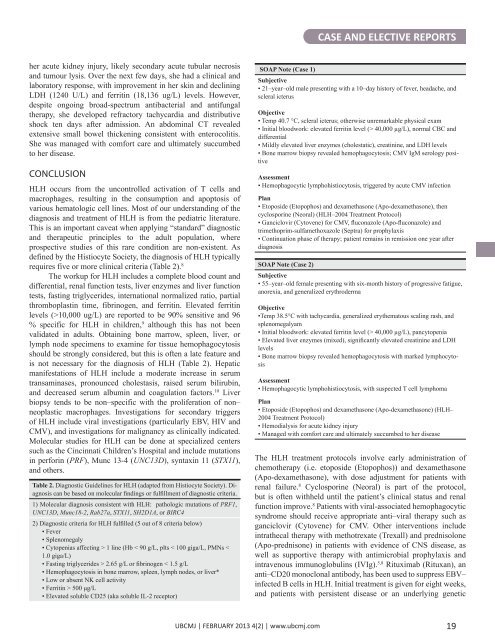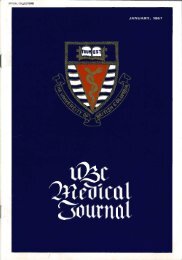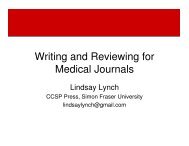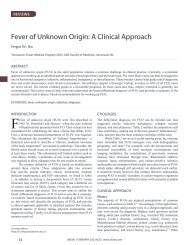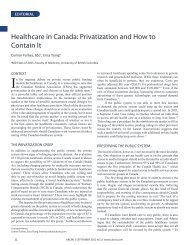Download full PDF - UBC Medical Journal
Download full PDF - UBC Medical Journal
Download full PDF - UBC Medical Journal
Create successful ePaper yourself
Turn your PDF publications into a flip-book with our unique Google optimized e-Paper software.
CASE AND ELECTIVE REPORTS<br />
her acute kidney injury, likely secondary acute tubular necrosis<br />
and tumour lysis. Over the next few days, she had a clinical and<br />
laboratory response, with improvement in her skin and declining<br />
LDH (1240 U/L) and ferritin (18,136 ug/L) levels. However,<br />
despite ongoing broad-spectrum antibacterial and antifungal<br />
therapy, she developed refractory tachycardia and distributive<br />
shock ten days after admission. An abdominal CT revealed<br />
extensive small bowel thickening consistent with enterocolitis.<br />
She was managed with comfort care and ultimately succumbed<br />
to her disease.<br />
CONCLUSION<br />
HLH occurs from the uncontrolled activation of T cells and<br />
macrophages, resulting in the consumption and apoptosis of<br />
various hematologic cell lines. Most of our understanding of the<br />
diagnosis and treatment of HLH is from the pediatric literature.<br />
This is an important caveat when applying “standard” diagnostic<br />
and therapeutic principles to the adult population, where<br />
prospective studies of this rare condition are non-existent. As<br />
defined by the Histiocyte Society, the diagnosis of HLH typically<br />
requires five or more clinical criteria (Table 2). 8<br />
The workup for HLH includes a complete blood count and<br />
differential, renal function tests, liver enzymes and liver function<br />
tests, fasting triglycerides, international normalized ratio, partial<br />
thromboplastin time, fibrinogen, and ferritin. Elevated ferritin<br />
levels (>10,000 ug/L) are reported to be 90% sensitive and 96<br />
% specific for HLH in children, 9 although this has not been<br />
validated in adults. Obtaining bone marrow, spleen, liver, or<br />
lymph node specimens to examine for tissue hemophagocytosis<br />
should be strongly considered, but this is often a late feature and<br />
is not necessary for the diagnosis of HLH (Table 2). Hepatic<br />
manifestations of HLH include a moderate increase in serum<br />
transaminases, pronounced cholestasis, raised serum bilirubin,<br />
and decreased serum albumin and coagulation factors. 10 Liver<br />
biopsy tends to be non–specific with the proliferation of non–<br />
neoplastic macrophages. Investigations for secondary triggers<br />
of HLH include viral investigations (particularly EBV, HIV and<br />
CMV), and investigations for malignancy as clinically indicated.<br />
Molecular studies for HLH can be done at specialized centers<br />
such as the Cincinnati Children’s Hospital and include mutations<br />
in perforin (PRF), Munc 13-4 (UNC13D), syntaxin 11 (STX11),<br />
and others.<br />
Table 2. Diagnostic Guidelines for HLH (adapted from Histiocyte Society). Diagnosis<br />
can be based on molecular findings or fulfillment of diagnostic criteria.<br />
1) Molecular diagnosis consistent with HLH: pathologic mutations of PRF1,<br />
UNC13D, Munc18-2, Rab27a, STX11, SH2D1A, or BIRC4<br />
2) Diagnostic criteria for HLH fulfilled (5 out of 8 criteria below)<br />
• Fever<br />
• Splenomegaly<br />
• Cytopenias affecting > 1 line (Hb < 90 g/L, plts < 100 giga/L, PMNs <<br />
1.0 giga/L)<br />
• Fasting triglycerides > 2.65 g/L or fibrinogen < 1.5 g/L<br />
• Hemophagocytosis in bone marrow, spleen, lymph nodes, or liver*<br />
• Low or absent NK cell activity<br />
• Ferritin > 500 μg/L<br />
• Elevated soluble CD25 (aka soluble IL-2 receptor)<br />
SOAP Note (Case 1)<br />
Subjective<br />
• 21–year–old male presenting with a 10–day history of fever, headache, and<br />
scleral icterus<br />
Objective<br />
• Temp 40.7 °C, scleral icterus; otherwise unremarkable physical exam<br />
• Initial bloodwork: elevated ferritin level (> 40,000 µg/L), normal CBC and<br />
differential<br />
• Mildly elevated liver enzymes (cholestatic), creatinine, and LDH levels<br />
• Bone marrow biopsy revealed hemophagocytosis; CMV IgM serology positive<br />
Assessment<br />
• Hemophagocytic lymphohistiocytosis, triggered by acute CMV infection<br />
Plan<br />
• Etoposide (Etopophos) and dexamethasone (Apo-dexamethasone), then<br />
cyclosporine (Neoral) (HLH–2004 Treatment Protocol)<br />
• Ganciclovir (Cytovene) for CMV, fluconazole (Apo-fluconazole) and<br />
trimethoprim-sulfamethoxazole (Septra) for prophylaxis<br />
• Continuation phase of therapy; patient remains in remission one year after<br />
diagnosis<br />
SOAP Note (Case 2)<br />
Subjective<br />
• 55–year–old female presenting with six-month history of progressive fatigue,<br />
anorexia, and generalized erythroderma<br />
Objective<br />
•Temp 38.5°C with tachycardia, generalized erythematous scaling rash, and<br />
splenomegalyam<br />
• Initial bloodwork: elevated ferritin level (> 40,000 µg/L), pancytopenia<br />
• Elevated liver enzymes (mixed), significantly elevated creatinine and LDH<br />
levels<br />
• Bone marrow biopsy revealed hemophagocytosis with marked lymphocytosis<br />
Assessment<br />
• Hemophagocytic lymphohistiocytosis, with suspected T cell lymphoma<br />
Plan<br />
• Etoposide (Etopophos) and dexamethasone (Apo-dexamethasone) (HLH–<br />
2004 Treatment Protocol)<br />
• Hemodialysis for acute kidney injury<br />
• Managed with comfort care and ultimately succumbed to her disease<br />
The HLH treatment protocols involve early administration of<br />
chemotherapy (i.e. etoposide (Etopophos)) and dexamethasone<br />
(Apo-dexamethasone), with dose adjustment for patients with<br />
renal failure. 8 Cyclosporine (Neoral) is part of the protocol,<br />
but is often withheld until the patient’s clinical status and renal<br />
function improve. 8 Patients with viral-associated hemophagocytic<br />
syndrome should receive appropriate anti–viral therapy such as<br />
ganciclovir (Cytovene) for CMV. Other interventions include<br />
intrathecal therapy with methotrexate (Trexall) and prednisolone<br />
(Apo-prednisone) in patients with evidence of CNS disease, as<br />
well as supportive therapy with antimicrobial prophylaxis and<br />
intravenous immunoglobulins (IVIg). 5,8 Rituximab (Rituxan), an<br />
anti–CD20 monoclonal antibody, has been used to suppress EBV–<br />
infected B cells in HLH. Initial treatment is given for eight weeks,<br />
and patients with persistent disease or an underlying genetic<br />
<strong>UBC</strong>MJ | FEBRUARY 2013 4(2) | www.ubcmj.com<br />
19


